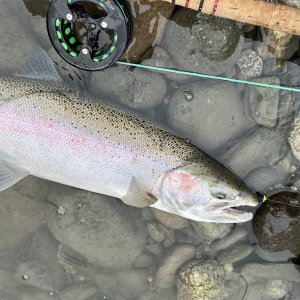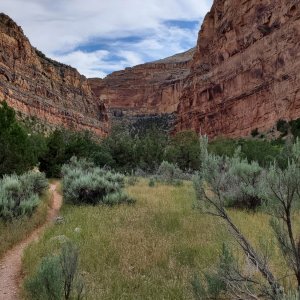Behind a paywall, but local PNW papers often reprint the story
You are using an out of date browser. It may not display this or other websites correctly.
You should upgrade or use an alternative browser.
You should upgrade or use an alternative browser.
Largest Dam Removal Project in the US-Klamath (Washington Post)
- Thread starter kmudgn
- Start date
Rob Allen
Life of the Party
Behind a paywall, but local PNW papers often reprint the story
I hope it works..
I grew up with the Rogue River before Lost Creek dam.I suspect the river, while free flowing, will be but a trickle of itself once the summer heats and low precipitation takes hold.
A guy could walk and wade safely in the summer.
Post Lost Creek dam, no way.
Divad
Whitefish
Here you go.I'm not paying to read it.
What I agree with is there are many more dams that need to be removed.
Thanks for posting this article.
I worked in the hydro industry for 28 years with much of my career spent working on fish passage studies and programs. I was born in Port Angeles and remember my grandfather stopping on the old one lane bridge over the Elwha and his stories about the 100 pound Chinook - if I remember right, the Elwha was a prototype program where the dams were permitted without fish passage (ladders) and hatcheries were implemented in lieu of passage. So with that long winded bunch of bullshit - I do have personal opinions on dams and andaromous fish. I don't see any immediate replacement for those monsters on the Columbia River unless we have a world wide reset where flood control, electrical generation and agricultural (irrigation) crops aren't needed anymore. But:
I think removing the Klamath dams is long overdue. Let's get it done and see if salmon, steelhead and lamprey respond: maybe yes, maybe no. The Elwha dams removal? Right on! The Snake River dams - ouch, bye bye.
Rob Allen
Life of the Party
Thanks for posting this article.
I worked in the hydro industry for 28 years with much of my career spent working on fish passage studies and programs. I was born in Port Angeles and remember my grandfather stopping on the old one lane bridge over the Elwha and his stories about the 100 pound Chinook - if I remember right, the Elwha was a prototype program where the dams were permitted without fish passage (ladders) and hatcheries were implemented in lieu of passage. So with that long winded bunch of bullshit - I do have personal opinions on dams and andaromous fish. I don't see any immediate replacement for those monsters on the Columbia River unless we have a world wide reset where flood control, electrical generation and agricultural (irrigation) crops aren't needed anymore. But:
I think removing the Klamath dams is long overdue. Let's get it done and see if salmon, steelhead and lamprey respond: maybe yes, maybe no. The Elwha dams removal? Right on! The Snake River dams - ouch, bye bye.
I'd say if the removal of Klamath river dams does not result in a reasonable restoration of wild fish then removing Snake river dams is completely off the table.
We have to start seeing results from our efforts and removing the snake river dams is going to create LOTS of enemies of salmon recovery. We need to show some success before we make such enemies so that we can justify our position.
Thank you.
When I was growing up in Medford I had dreams of fishing the Klamath River on the Oregon side.
For some reason I couldn't talk my dad into it.
After I was old enough to drive, I was told the fishing sucked and the rattle snakes were thick.
Plus there was a long dirt road to travel.
I'm gonna bet that the rattle snakes are still thick but in a couple years the fly fishing is gonna be great.
Removing the Klamath River dams won't recover ESA-listed salmon by itself. But it is the single action that will help the most. Removing these dams is a legal and environmental issue. The dams are (or were) owned by Pacificorp. The dams were licensed by the Federal Energy Regulatory Commission (FERC). Under the Federal Power Act (FPA), as amended, those dams are required to provide safe, timely, and effective upstream and downstream fish passage if prescribed by the National Marine Fisheries Service (NMFS) or the US Fish and Wildlife Service (USFWS). During dam relicensing studies Pacificorp found that the cost of adding fish passage, along with other mandatory mitigation measures, made the dams uneconomic, meaning they don't generate enough energy to cover the costs of dam O&M and the legally mandated mitigation measures. In a nutshell, those dams are only economically worthwhile if they are "subsidized" with fish, wildlife, and other public resource losses. Energy companies and utilities are not in the habit of operating uneconomical projects, so surrender of the FERC license and dam removal was the only viable alternative. Oh, don't think that Pacificorp didn't try to maintain licensing and operating with the natural resource subsidy. They pursued a legal remedy, but the fish agencies and tribes prevailed.
The natural and logical question that most don't ask is, if a private corporation project on publicly owned land and water is only profitable without mitigating losses to publicly owned fish and wildlife, then is licensing that project truly in the public's best interest?
The natural and logical question that most don't ask is, if a private corporation project on publicly owned land and water is only profitable without mitigating losses to publicly owned fish and wildlife, then is licensing that project truly in the public's best interest?
Isn't the answer to that query self-evident? Seems as it has been well demonstrated that corporate policy encourages maximum profit potential especially when the bill is covered by the general public and its interests.The natural and logical question that most don't ask is, if a private corporation project on publicly owned land and water is only profitable without mitigating losses to publicly owned fish and wildlife, then is licensing that project truly in the public's best interest?
Last edited:
If that answer were self evident, FERC wouldn't be issuing licenses without mandating full mitigation of project impacts. But they do unless we're there to prevent it.Isn't the answer to that query self-evident? Seems as it has been well demonstrated that corporate policy encourages maximum profit potential especially when the bill is covered by the general public and its interests.
Rob Allen
Life of the Party
Profit is the entire reason for being in business and that is a good thing. Without it nobody has anything . It's not wrong to use public property to create private profit..Isn't the answer to that query self-evident? Seems as it has been well demonstrated that corporate policy encourages maximum profit potential especially when the bill is covered by the general public and its interests.
I think you meant to add: "Provided that the public is properly compensated for that use."It's not wrong to use public property to create private profit..
Zak
Legend
Also not wrong for the public to put conditions on the private use of public land and require compliance with federal environmental laws. If the company can't make a profit without violating the law, then it can GTFO.Profit is the entire reason for being in business and that is a good thing. Without it nobody has anything . It's not wrong to use public property to create private profit..
Rob Allen
Life of the Party
Maybe some.. as long as it doesn't make the endeavor unprofitable.I think you meant to add: "Provided that the public is properly compensated for that use."
Rob Allen
Life of the Party
As long as those laws aren't designed to keep the company from being profitable.Also not wrong for the public to put conditions on the private use of public land and require compliance with federal environmental laws. If the company can't make a profit without violating the law, then it can GTFO.
No shades of gray in Rob World.Profit is the entire reason for being in business and that is a good thing. Without it nobody has anything . It's not wrong to use public property to create private profit..
It looks like you're saying that the public should partially subsidize the project. I disagree. Here's one reason why.Maybe some.. as long as it doesn't make the endeavor unprofitable.
Context matters when evaluating and analyzing a project from economic and environmental perspectives. For example, the Edwards Dam on the Kennebec River in Maine was constructed in 1906. At that time labor was very cheap, and materials weren't too expensive either, considering that the dam didn't meet safety standards from the time there were any safety standards (none in 1906). And environmental requirements were nonexistent. But even a small amount of electricity (what Edwards produced) was extremely valuable in the early 20th century. By the year 2000, when the dam was long overdue for FERC licensing, the dam was barely breaking even economically because costs and values for everything had shifted significantly. Under a new FERC license, Edwards was required to add fish passage. The dam owner couldn't add fish passage and still break even, let alone make a profit. The amount of energy produced was negligible by today's standards. From what you posted, it appears that you would have the public subsidize Edwards in perpetuity. Would you even suggest the government should give the project your tax dollars if it couldn't turn a profit at any future date? That's what it looks like. In 1996 a FERC Administrative Law judge ruled that hydropower projects (Meade Decision) must provide mitigation proportionate to impacts. So FERC is supposed to issue licenses with terms and conditions that achieve that goal. And it is not the federal government's responsibility to ensure that a project is economically viable. FERC is supposed to issue a license with appropriate terms and conditions, and it's up to the project proponent (owner) to decide if it's worth building or continuing to operate the project.
This was the case with the Elwha dams. They were 2 quite tall hydro dams with only 26 MW of capacity and producing just 12 average MW of power. They were only profitable because when they were built in 1911, that was a valuable amount of energy. Today it's a rounding error at a utility. So they weren't worth operating under the terms of a new license, and the upper dam was in a national park, so a license couldn't be issued for it anyway.
The 4 Klamath dams are victims of time. Things change. They were economically marginal without any mitigation. There was no way to issue a new license that would be profitable for Pacificorp without violating the Meade Decision. Even concrete hydro dams don't last forever. So when they reach the end of their useful life you have to either decommission them in place or remove them.
Another good example is Glen Canyon Dam on the Colorado River. The Bureau of Reclamation (BOR) over-estimated the water supply in the river system when Glen Canyon was constructed. Whether that was deliberate or just an inadequate data set will likely never be known. The Director of BOR was in competition with the Corps of Engineers to see who could build the most and biggest dams, so things like economic feasibility were buried well enough that Congress (who must authorize the projects) couldn't find it or just really didn't want to know anyway. The upshot is that Glen Canyon reservoir (Lake Powell) hasn't been at full pool in years and probably never will be again. It sits at something like 70 or 100 or more feet below full, and at anything near the present rate will drop to lowest point at which it can get water into the turbine intakes (penstocks) and will have to stop operating. This is critically important because the project sets just upstream from the beginning of Grand Canyon and feeds Hover Dam and Lake Meade downstream, which supplies water to Los Angeles and the California-Arizona Project (CAP). Seven states hold water rights to the Colorado River for more water than the river produces, except in above average water years. So I ask you, should the US government continue to operate a project that costs more than the energy it produces is worth? And how will they operate it when the water level doesn't reach the penstock intakes?
Sometimes removing a dam is the best course of action, both economically and environmentally.












